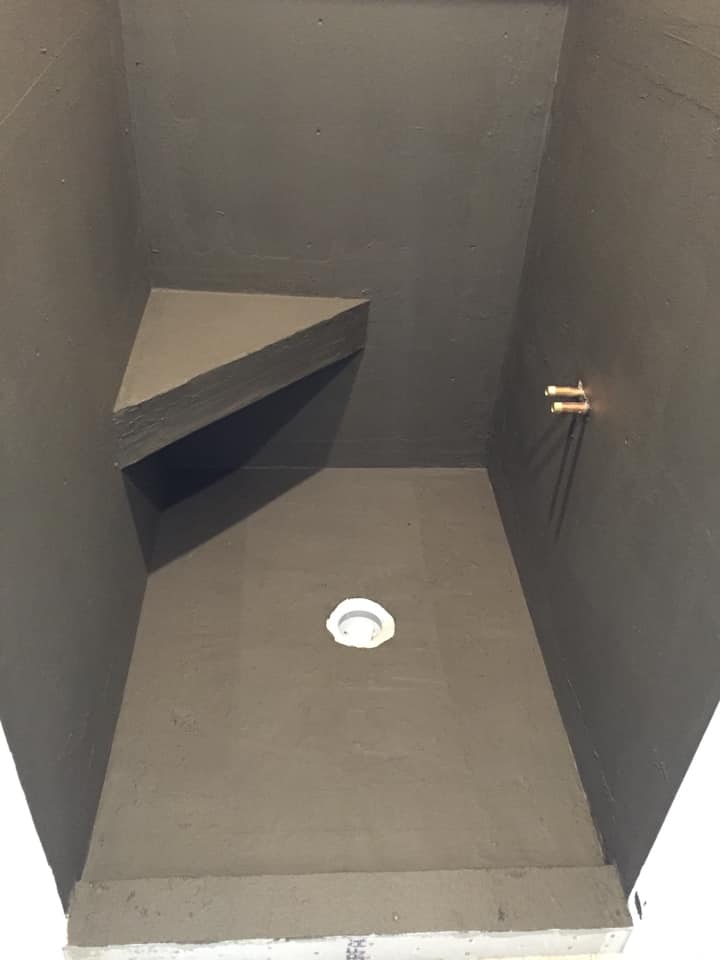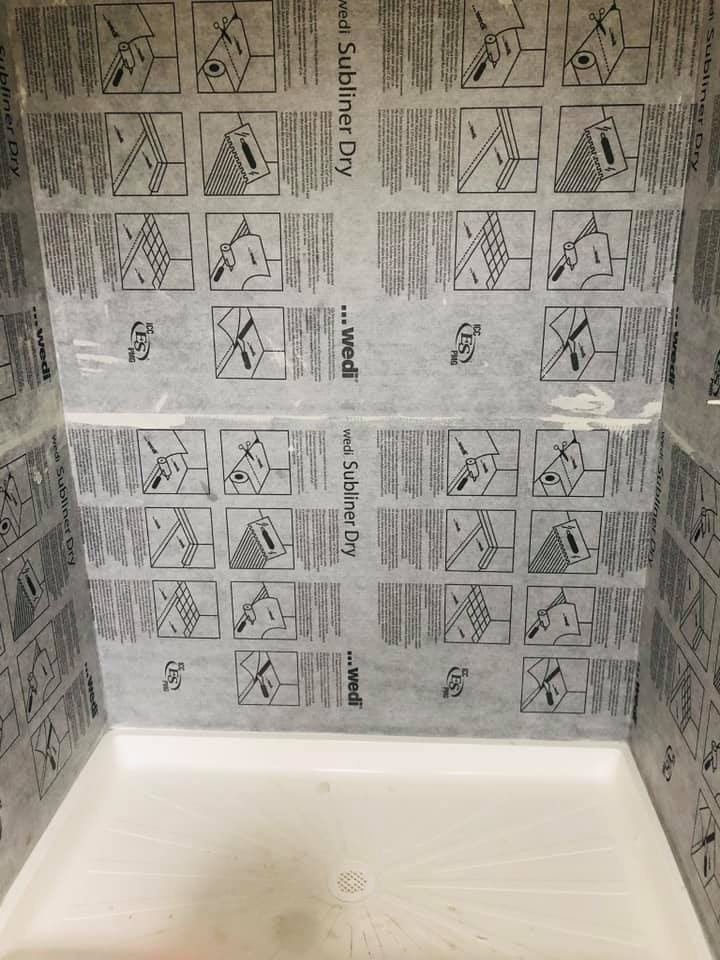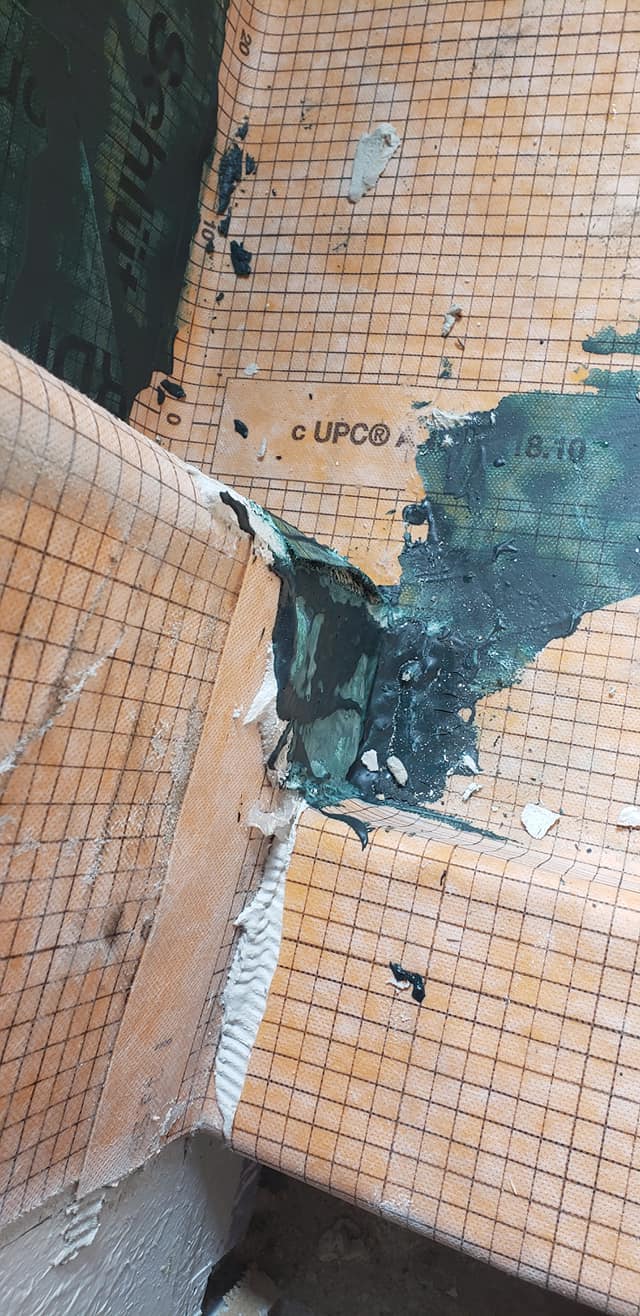Ed: This story originally appeared in the August 2020 issue of TileLetter.
Today’s tile installations enjoy a tremendous amount of flexibility and creativity in methods, materials, and design. While a few decades ago there was only one option for waterproofing shower stalls, today we have myriad options. One tempting method is the Franken-shower, or hybrid shower system. But what risks are there and when is it the appropriate choice?
What is a hybrid?
With topical applications like B421 and B422 in the TCNA Handbook for Ceramic, Glass and Stone Tile Installation, which call for an ANSI A118.10 load-bearing, bonded, waterproof membrane, the membrane extends continuously from the drain to above the shower head.
A membrane can either be sheet-applied or liquid-applied. Typically, a sheet-applied membrane calls for a 2” overlap at seams, corners, and penetrations. This is usually a band of the same material applied with thinset or an approved adhesive. A hybrid system is a liquid-applied membrane at corners and seams to create the waterproof overlap.

Properly-installed liquid applied membrane
Photo: Jake Shaefer

Properly-installed sheet applied membrane
Photo: Jeff Tomczak
Some contractors who use this method do so simply because they don’t trust the science behind thinset bonding a 2” overlap to maintain a waterproof seal. The internet is replete with videos of contractors conducting their own tests to determine whether or not a system or material is actually waterproof. Other contractors prefer the ease of liquid-applied membranes over a seam. Still others don’t like the potential build-up of overlapping membranes .
Trust the methods and manufacturers
That said, one of the most valuable resources we have available to us in the tile industry are ANSI standards and TCNA methods. When we use materials that meet ANSI A118.10 we can trust they will perform as a waterproof system. This being the case, we can and should trust the manufacturers when their materials are installed correctly. And in the TCNA Handbook, we find this language regarding installation of waterproof membranes: “Bonded waterproof membrane must be continuous, including at changes in plane. Follow membrane manufacturer’s requirements for corners, seaming, and overlap.” Emphasis is mine.
Let’s take a closer look and see what challenges and risks tile contractors take when they build a hybrid shower system.
You don’t know what you don’t know
The first potential issue tile contractors should be aware of is introducing technical unknowns into the system. Potential material incompatibilities may arise when mixing waterproofing systems and materials.
As contractors, we simply can’t know for sure how different materials will interact with one another. The liquid might require a mechanical profile to grab onto, or the sheet might not allow the liquid to integrate fully into the fabric, thus potentially allowing water to migrate behind the liquid membrane, leading to a failure. Since we can’t speak to the composition of the different materials and how they’ll interact, care should be taken in mixing components from different manufacturers. Ask yourself the following: If there is a failure, where would the fault lie? In the liquid seam? Or in the fabric material? How could that be determined?
In this case the failure, and liability, would lie squarely on the shoulders of the installer.
It’s worth noting that some manufacturers allow for a liquid seam mixed with their sheet membrane. Since they are able to test in a laboratory setting, they can confirm the suitability and compatibility of these installations in their systems. This is key to deciding if a hybrid approach is the right one for your installation. If you prefer building your shower systems in this way, choose a system designed for it.
Partnering with a manufacturer benefits your client
The second issue you should consider is what the manufacturer recommends. A huge strength of our industry is the partnerships between installers and manufacturers. Our trade benefits from the support and knowledge that is available to each and every one of us. Following the recommendations of the manufacturers of the products we use is the simplest step we can take in our partnership.
A popular sentiment and statement is “my word is my warranty.” Unfortunately, it is not that simple. When companies write warranties, they are binding legal language. In other words, if you meet the terms of a warranty, they must as well. And these companies want to partner with us, and so they want to make sure you and your client are taken care of. Manufacturers want to stand with you behind their product. Often, manufacturers’ reps will even go beyond what’s required of them by the terms of the warranty to help installers in the field and to educate them. Of course, as noted above, that may be the start of a long-term partnership between the company and you.
Consider this: in 2020 we suffered an economic shutdown that could not be avoided due to COVID-19. Many small businesses went under, as they could no longer afford to stay in business. Others encountered health issues associated with our trade and must retire early or change careers. If in two years, a client needs a repair on their shower, but their installer is no longer in operation, who will they call? If they believe their shower was built as a system and is under warranty, they will call the system manufacturer. When the manufacturer comes to inspect the installation and determines that an unapproved hybrid system was “designed” by an installer who is no longer in business, what recourse will the homeowner have?
All this is to say we have an ethical obligation as professionals to our clients to make sure that not only is their shower built with proper methods, but proper materials as well. If we “design” our own hybrid system out of materials we happen to like, not only are we assuming all liability on ourselves, but we are actively voiding the client’s warranty, robbing them of their legal rights.
These are vital questions you should ask yourself:
- Are you introducing technical unknowns into the system, and with them potential failures and health risks for your client?
- Are you actively voiding your client’s warranty?
Perhaps this won’t change your mind on the subject. However, the fact remains that hybrids come with their own sets of hazards and risks.


Joseph Mattice
Joseph Mattice is a CTEF Certified Tile Installer #1155 and Owner of On the Level, LLC, located in South Carolina.







